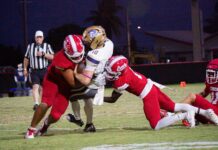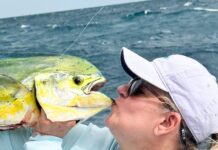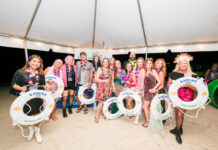Driving up and down the Florida Keys, millions of people have traveled through Islamorada and over the series of bridges and fills that link Upper Matecumbe to Lower Matecumbe Key. While moving between the two islands, a small, seemingly nondescript island appears in the Atlantic shallows.
It is about one mile offshore. The island, shrouded in mangroves, offers an excellent example of judgments made about books simply by the look of their covers.
Bahamian sailors called it Kay Comfort. Located about midway along the Florida Reef, it possessed a naturally occurring deep harbor and maintained a reputation for being relatively mosquito-free. Also, nearby Lower Matecumbe Key was home to a series of fresh-water wells. Some historical accounts considered them to be the most reliable source of fresh water in the Keys.
On a chart created by George Gauld in 1775, the island was identified as Kay Comfort and its modern name, Indian Key. Today, the island is home to Indian Key Historic State Park. A true overlooked gem, there was a time when it was the most important island in the Keys that was not named Key West.
Indian Key faded as a community, and Key West grew to become the wealthiest city, per capita, in the United States. The money flowed onto the island across the decks of the wrecking industry. Had one or two breaks gone this way instead of that, their stories would have likely been quite different.
When Spain transferred ownership of the Florida Territory to the United States through the Adams-Onis Treaty (1819-1821), there was a great deal more to Florida than just the Sunshine State. The Florida Territory was composed of East Florida, which included the panhandle and stretched from the Atlantic Ocean to the Suwannee River, and West Florida, which ended at the Mississippi River, the Keys and the Florida Reef.
Before the acquisition, wreckers plying their trade in the Straits of Florida and along the third largest barrier reef system in the world worked on schooners and skiffs flying different flags. Wreckers flying Spanish flags brought any cargos salvaged to Havana. Those under English flags sailed for Nassau.
Change was in the making. Key West was declared a U.S. port of entry on May 7, 1822. The next step was enacting new laws. On July 4, 1823, the first attempt at officially documented U.S. wrecking reform was enacted: “Concerning wreckers and wrecked property: WHEREAS it is necessary that prompt and efficient protection should be given to wreckers and to the owners of wrecked property brought within the limits and jurisdiction of this Territory: Be it enacted by the Governor and Legislative Council of the Territory of Florida, And it is hereby enacted by the authority of the same, That whenever wrecked property of any description whatsoever shall arrive, be brought in or landed in any part of this Territory, it shall be the duty of the salvor or salvors, owner or owners, or their representatives, or other persons having charge of the same, to make report of the fact of such arrival to such justice of the peace or notary public as may reside next adjacent to the place of arrival.”
Cargo salvaged from an American interest was to be brought to an American port of entry. In 1823, the territory’s east coast had two: St. Augustine and Key West. There was a time, as Indian Key was establishing itself as a force, when the Territorial Congress received letters requesting that the island be declared a third port of entry. The first letter was sent in 1828 but was ignored. As the Indian Key community continued to grow, additional petitions were sent.
There were legitimate reasons to consider Indian Key a suitable port of entry. It was not just some convenient harbor in times of emergency, but a destination where sailors could stop to stretch their legs, get a warm meal and shoot a game of pool. They could also acquire provisions at one of the two general stores on the island.

The stores at Indian Key were not visited casually, as would be revealed when, on April 23, 1833, it was recorded that, “One store on this island sold in the last 12 months merchandise to the amount of 25 thousand dollars. ¼ part of this sum was purchased by residents of the mainland – the remaining ¾ by inhabitants of the Keys and by vessels who resort here for supplies.”
Adjusting for inflation, $25,000 in 1833 would be worth in the neighborhood of $950,000 in 2025. A second letter requesting that the island become a port of entry was drafted by the “Inhabitants of Indian Key” on July 23, 1833. It was signed not just by residents of Indian Key, but also by “Florida Shippers, Underwriters, Masters of Vessels, and others interested in the commercial and wrecking concerns of the Gulf and Reef of Florida.”
Included in the letter was: “Much the greatest part of Court & Customs House business in this District originates in the disasters that so frequently occur in navigating these seas – and more than three fourths of these accidents take place in the vicinity of Indian Key.”
In addition, it was noted that “the rapid increase of business at and in the vicinity of the Island renders it exceedingly desirable that Indian Key should be made a Port of Entry and a Custom House…”
For the second time, the request was denied. In 1839, a third petition was sent to the Territorial Congress, and, for a third time, the request was denied. Politics were involved. It would have been interesting if the politics behind those making the decision had broken the other way. Because Indian Key was more conveniently located along the Florida Reef than Key West, in many cases, wreckers would not have had to sail as great a distance to register their salvaged cargo. The money that poured into Key West would have been diverted to Indian Key, and the history of both islands would have been recorded in books much differently than they are today.





















